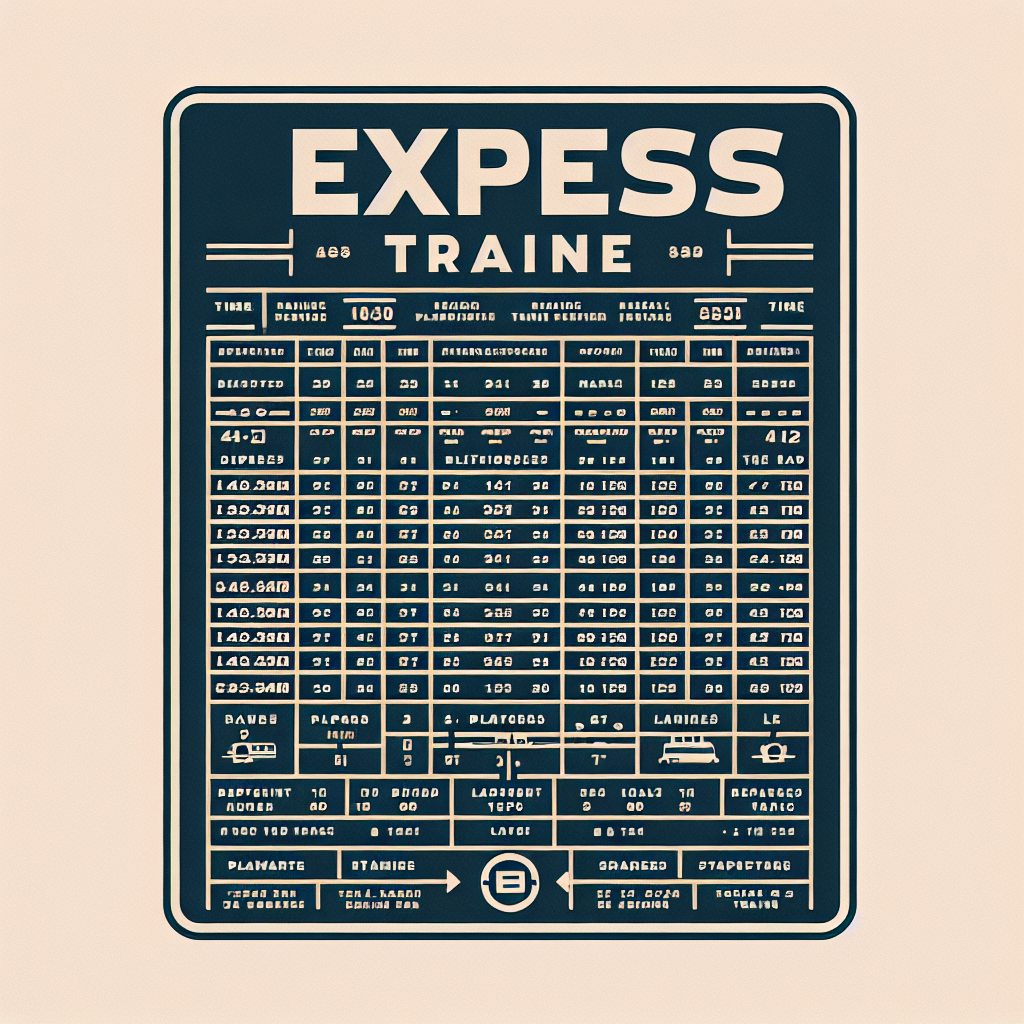Understanding the GT Express Time Table: A Comprehensive Guide

The GT Express, a popular mode of transportation in many regions, offers a reliable and efficient way to travel. Understanding its time table is crucial for passengers who rely on this service for their daily commute or occasional travel. This article delves into the intricacies of the GT Express time table, providing valuable insights, examples, and statistics to help you navigate this essential travel resource.
The Importance of the GT Express Time Table
The GT Express time table is more than just a schedule; it is a lifeline for many commuters. It ensures that passengers can plan their journeys effectively, minimizing wait times and maximizing convenience. Here are some reasons why the GT Express time table is vital:
- Efficiency: A well-structured time table allows for efficient travel planning, reducing the time spent waiting for trains.
- Reliability: Passengers can rely on the time table to provide accurate information about train arrivals and departures.
- Convenience: With a clear schedule, passengers can choose the most convenient train times for their needs.
- Resource Management: Operators can manage resources better by understanding peak travel times and adjusting services accordingly.
Components of the GT Express Time Table
The GT Express time table is composed of several key components that passengers need to understand to make the most of their travel experience. These components include:
Train Numbers and Names
Each train in the GT Express network is assigned a unique number and name. This helps passengers identify the specific train they need to board. For example, Train 101, known as the “Morning Star Express,” might run from City A to City B.
Departure and Arrival Times
The time table lists the departure and arrival times for each train at various stations along its route. This information is crucial for planning connections and ensuring timely arrivals at destinations.
Frequency of Service
The frequency of service indicates how often a particular train runs. Some trains may operate daily, while others might run only on specific days of the week. Understanding this aspect helps passengers plan their trips accordingly.
Route Information
The time table provides detailed route information, including all the stops a train makes along its journey. This is essential for passengers who need to disembark at intermediate stations.
How to Read the GT Express Time Table
Reading the GT Express time table can be daunting for first-time users. However, with a little guidance, it becomes a straightforward task. Here’s a step-by-step guide:
Step 1: Identify Your Train
Start by identifying the train you need to take. Use the train number or name to locate it in the time table.
Step 2: Check Departure and Arrival Times
Once you’ve found your train, check the departure time from your station and the arrival time at your destination. Make sure to account for any time zone differences if applicable.
Step 3: Note the Frequency
Verify the frequency of the train service to ensure it runs on the day you plan to travel.
Step 4: Review the Route
Examine the route information to confirm that the train stops at your desired station.
Case Study: The Impact of GT Express Time Table on Commuters
To illustrate the significance of the GT Express time table, let’s consider a case study involving commuters in a bustling metropolitan area.
Background
In City X, the GT Express serves as a primary mode of transportation for thousands of daily commuters. The city’s residents rely heavily on the train service to reach their workplaces, schools, and other destinations.
Challenges
Before the implementation of an optimized time table, commuters faced several challenges:
- Long wait times at stations due to infrequent train services.
- Overcrowded trains during peak hours.
- Inconsistent train schedules leading to missed connections.
Solution
The GT Express management team conducted a thorough analysis of passenger data and travel patterns. They introduced a revised time table with the following improvements:
- Increased frequency of trains during peak hours to reduce overcrowding.
- Adjusted train schedules to ensure better connections with other modes of transportation.
- Implemented real-time updates to inform passengers of any delays or changes.
Results
The revised time table led to significant improvements in commuter satisfaction. According to a survey conducted six months after the changes:
- 85% of commuters reported reduced wait times.
- 75% experienced less crowded trains during peak hours.
- 90% appreciated the real-time updates provided by the GT Express app.
Statistics: The Broader Impact of Efficient Time Tables
Efficient time tables are not only beneficial for individual commuters but also have a broader impact on the transportation system and the environment. Consider the following statistics:
- Reduced Traffic Congestion: A study by the Urban Transportation Institute found that cities with well-optimized train schedules experienced a 20% reduction in road traffic congestion.
- Environmental Benefits: According to the Environmental Protection Agency, increased use of public transportation can lead to a 45% reduction in greenhouse gas emissions per passenger mile compared to private vehicles.
- Economic Impact: The American Public Transportation Association reports that every $1 invested in public transportation generates approximately $4 in economic returns.
Conclusion: The Future of GT Express Time Tables
The GT Express time table is an essential tool for ensuring efficient and reliable train services. By understanding its components and how to read it, passengers can make informed travel decisions. The case study from City X demonstrates the positive impact of an optimized time table on commuter satisfaction and overall transportation efficiency.
As technology continues to advance, the future of GT Express time tables looks promising. Real-time updates, integration with mobile apps, and data-driven scheduling are just a few innovations that will enhance the passenger experience. By prioritizing efficient time tables, transportation authorities can contribute to a more sustainable and connected future.
In summary, the GT Express time table is not just a schedule; it is a vital component of modern transportation systems. Its role in improving efficiency, reliability, and convenience cannot be overstated. As we


